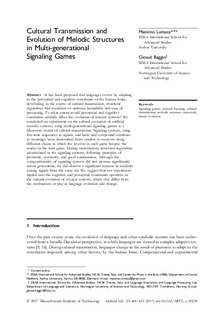| dc.description.abstract | It has been proposed that languages evolve by adapting to the perceptual and cognitive constraints of the human brain, developing, in the course of cultural transmission, structural regularities that maximize or optimize learnability and ease of processing. To what extent would perceptual and cognitive constraints similarly affect the evolution of musical systems? We conducted an experiment on the cultural evolution of artificial melodic systems, using multi-generational signaling games as a laboratory model of cultural transmission. Signaling systems, using five-tone sequences as signals, and basic and compound emotions as meanings, were transmitted from senders to receivers along diffusion chains in which the receiver in each game became the sender in the next game. During transmission, structural regularities accumulated in the signaling systems, following principles of proximity, symmetry, and good continuation. Although the compositionality of signaling systems did not increase significantly across generations, we did observe a significant increase in similarity among signals from the same set. We suggest that our experiment tapped into the cognitive and perceptual constraints operative in the cultural evolution of musical systems, which may differ from the mechanisms at play in language evolution and change. | nb_NO |
